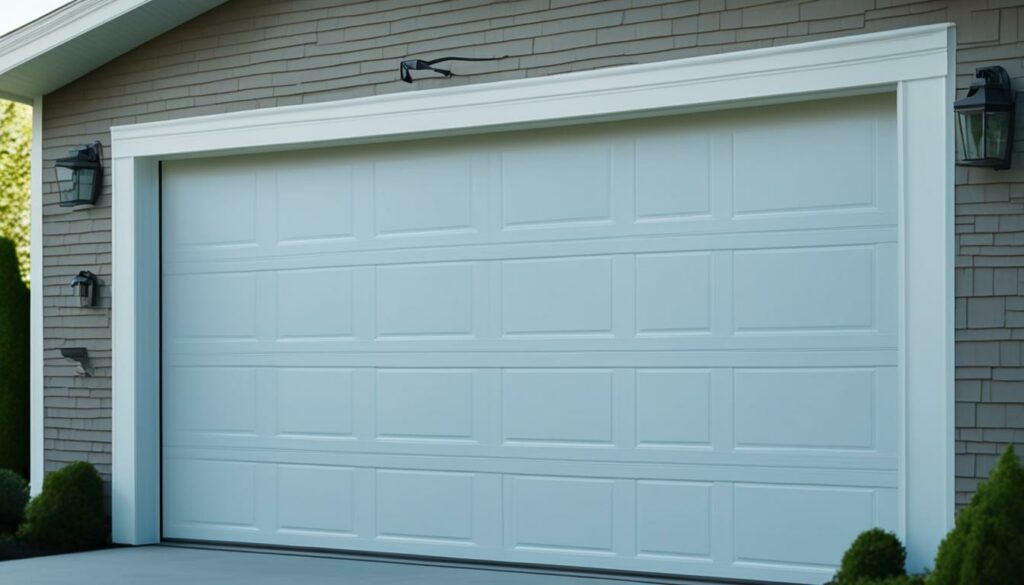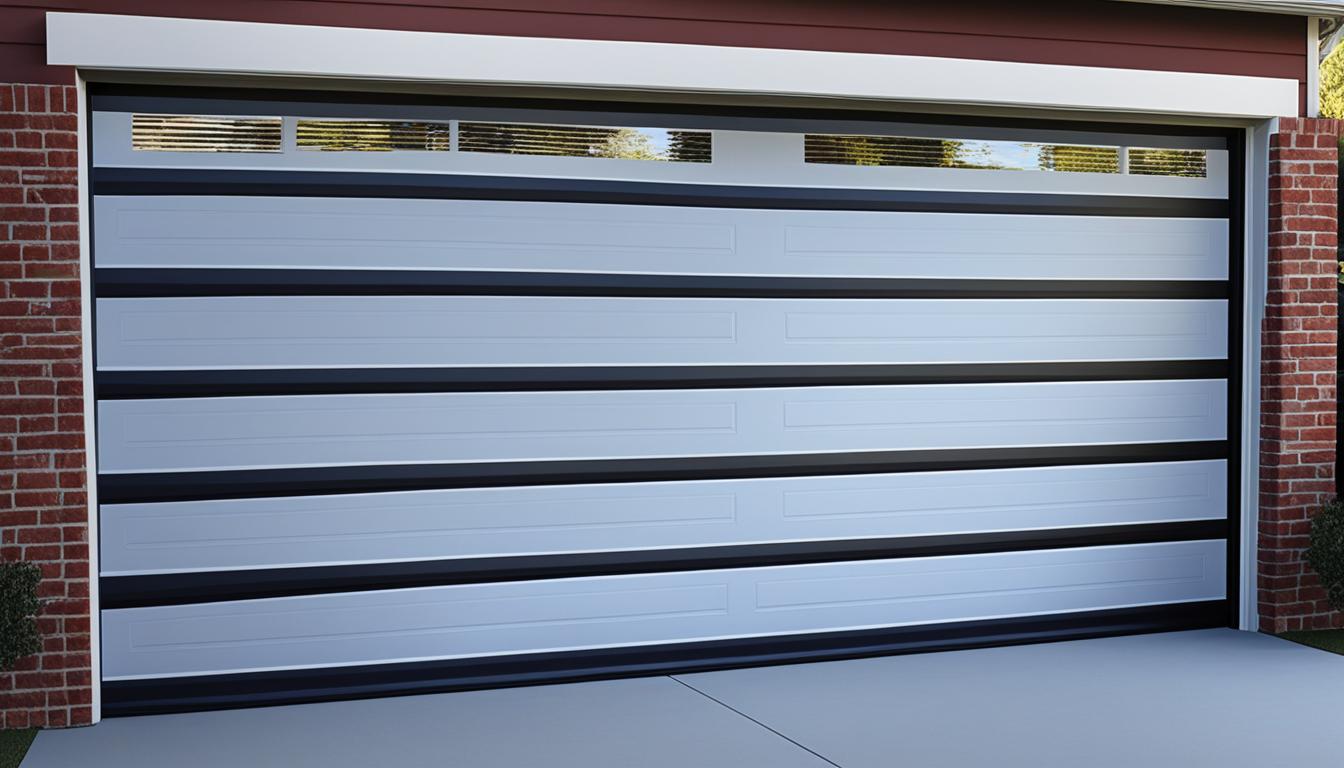Ever thought about how garage door weather stripping changes your home’s comfort? It’s simple but vital. By sealing your garage door gaps, it keeps out unwanted cold or heat. This improves your home’s energy efficiency.
Materials like rubber and vinyl make these seals. They block cold drafts, moisture, and pests. Effective weatherproofing also prevents rust from moisture. Companies such as Impact Doors offers weather stripping service. They fit all types of doors, including sectional and roller doors.
Installing weather stripping right can cut your energy bills. It keeps your garage’s temperature comfy. Make sure to check and replace old seals. This keeps them working well. There are many kinds of seals to pick, all designed to shield your garage. Proper installation and regular maintenance ensure maximum efficiency and longevity of your weather stripping. Additionally, insulating a garage panel can further enhance temperature control by reducing heat loss or gain through the door itself. Combining these methods creates a well-sealed and energy-efficient garage, making it more comfortable and cost-effective year-round.
Key Takeaways
- Garage door weather stripping is vital for insulating against environmental elements.
- Materials like rubber and vinyl are commonly used for weatherproofing garage doors.
- Proper weather stripping helps maintain temperature regulation and prevent moisture-related issues.
- Professional installation is recommended to ensure proper alignment and effectiveness.
- Regular maintenance and prompt replacement of worn-out seals can extend the lifespan of your garage door.
- Investing in weather stripping can lower utility bills by up to 30%.
- Companies like National Garage Remotes & Openers provide a wide range of compatible weather stripping options.
For more information about what garage door weather stripping is and how it can benefit your home, visit our page on garage door repairs in Deception Bay.
How often do you need to replace weather stripping on a garage door?
It’s vital to replace the weather stripping on your garage door to keep it working well. How often you need to do this varies. It depends on the stripping’s quality and what it goes through weather-wise. High-quality rubber or PVC can last nearly 30 years if it’s put in right and cared for. But if it’s not installed right, you might have to replace it in just a few months.
Bad installation is behind most weather stripping issues. Doing regular clean-ups every three months can make them last longer. You should also look for any damage like cracks every 6-12 months to keep things running smoothly.
How much does it cost to replace rubber strip on garage door?
Replacing a garage door’s rubber strip can cost differently based on a few things. Things like the material type and your garage door’s size matter. The price might be just a few dollars or more if you need a pro to do it. The choice between high-quality PVC or cheaper materials affects costs too. Cheaper options may mean you have them more replacement often. Understanding the importance of garage door weather stripping is crucial for maintaining a comfortable and energy-efficient garage environment. To explore the financial aspects of replacing a garage door, including material costs and installation expenses, check out the resource on financial planning for garage door replacement. This will help you make informed decisions and budget effectively for your garage upgrade, ensuring optimal performance and savings in the long run.
| Material | Average Lifespan | Average Cost | Maintenance Required |
|---|---|---|---|
| High-quality PVC | More than 20 years | Moderate | Regular cleaning and lubrication |
| Low-grade rubber | Less than 5 years | Low | Frequent replacements |
Is it easy to replace weather stripping?
Many people wonder if replacing weather stripping is easy. Yes, it can be, especially with kits and clear guides available. But, it’s important to put it on right to make sure your garage stays insulated. While you can do it yourself, sometimes it’s better to get a professional. They make sure it’s done right and will last longer. Considering garage door weather stripping options is crucial for homeowners seeking to enhance the energy efficiency and weatherproofing of their garage. For information on upgrading to commercial-grade garage doors with enhanced durability and security features, explore the resource on commercial garage door upgrades.
Getting a pro to install it means it fits well and is secure. This keeps your garage door insulated better and lowers the risk of damage. Regular checks and maintenance help keep your weather stripping in top shape for longer.
What is the purpose of weather stripping doors?

The purpose of weather stripping doors is to keep the garage’s temperature steady. It makes the space warmer in winter and cooler in summer. This helps protect stored items from moisture and rust.
Do garage doors need weather stripping?
Yes, garage doors need weather stripping. Even doors that fit well have gaps that let in rain, snow, and ice. Weather stripping seals these gaps. It keeps the weather out. A garage door threshold seal stops water from getting in, especially if your driveway slopes down to the garage. Understanding garage door weather stripping options is essential for ensuring a well-insulated and weather-resistant garage. To ensure compatibility between your garage door size and weather stripping solution, refer to the resource on matching garage door size with weather stripping. This will help you achieve a seamless integration, maximizing the effectiveness of both components.
Is weather stripping worth it?
Weather stripping is definitely worth it. It controls the temperature and cuts down your energy bills. It stops water, rust, and damage to equipment. It also keeps out pests, making your garage safer and drier. When considering garage door weather stripping options, it’s essential to also factor in the overall cost of upgrading your garage door. To learn more about budgeting for garage door upgrades, including the cost of materials and installation, explore the resource on budgeting for garage door upgrades. This will help you plan your garage renovation project effectively and ensure that you stay within your budget.
What are the three types of door weather stripping?
There are three main door weather stripping types for different doors. Here they are:
- Perimeter Seals: These go on the door frame’s sides and top to seal edge gaps.
- Bottom Seals: Known as astragals, these are at the door’s bottom to stop water and debris.
- Threshold Seals: Installed on the garage floor, they make a barrier against outside elements.
Choosing the right type helps you get the most benefits of weather stripping.
How do you fix weather stripping in a garage?

Fixing the weather stripping on your garage door is key. Start by selecting the right material for your door. Then, carefully follow the guide to install it.
How do I keep my garage door from sticking to the weather stripping?
To prevent your garage door from sticking, install the weather stripping correctly. It should seal well but still let the door move. Don’t forget to lubricate it. Checking that everything fits right is important for smooth use.
Can you replace the rubber seal at the bottom of a garage door?
Yes, replacing the rubber seal on your garage door is possible. This U-shaped weather-stripping can get worn out. To replace it, lift the door, remove the old seal, clean the retainer, and put in a new one. Make sure the new seal fits right to avoid gaps.
How tight should garage door weather stripping be?
The weather stripping needs to be the right tightness. It should seal against the weather but let the door work easily. Checking and adjusting it will keep things working right.
- Weather stripping typically ranges from 7 to 9 feet long
- It is recommended to cut side pieces about 1/4-inch shorter than garage height
- DIY weather stripping replacement is feasible for homeowners
In Central Pennsylvania, Cornwell Door Service has helped since 1972. Keeping your door’s seals right can lower bills and keep your garage safe. It makes your garage a better part of your home.
What is the strip at the bottom of the garage door called?
The strip at the bottom of a garage door is called a bottom seal or astragal. It’s made from materials like vinyl or rubber. It keeps out debris, water, and cold air. This keeps your garage energy-efficient by blocking the elements and pests.
What is the most common garage door bottom seal?
The U-shaped beaded seal is very common. It fits into the door’s bottom on a retainer. It’s wider than the door. Bulb-shaped seals press against the ground for a tight seal. T-style and J-style seals are good against moisture and wind.
How to weatherproof a garage door?
To keep your garage door weatherproof, add stripping around it. This includes the top and sides, not just the bottom. Using good materials for these seals improves insulation. This can save you up to 30% on bills. Checking these seals twice a year keeps them in good shape.
Why can I see daylight around my garage door?
Seeing daylight around your garage door means the seals might be worn or wrong. Gaps can increase energy costs and let pests and debris in. Replacing these seals properly can stop these issues. It also improves your garage’s insulation.
Garage Door Repair Near You
When you need professional Garage Door Repair, contact Jarred at Impact Doors. Our expert technicians are dedicated to fixing any issues swiftly and efficiently, guaranteeing your garage door functions flawlessly. Avoid the hassle of a broken garage door—call us today at (07) 5451 4022 to arrange your repairs.

